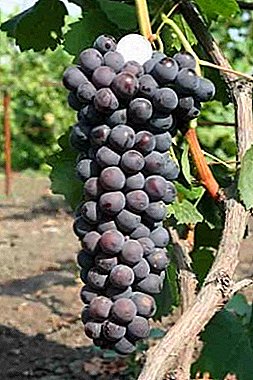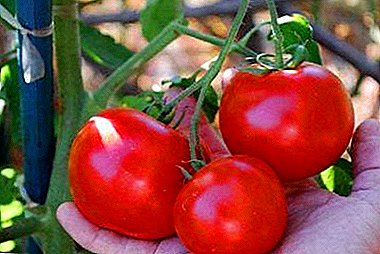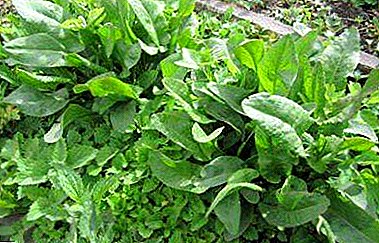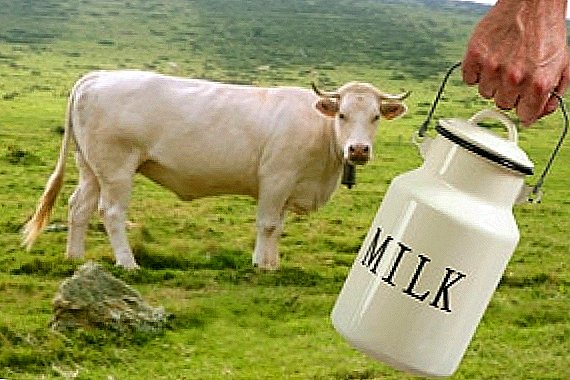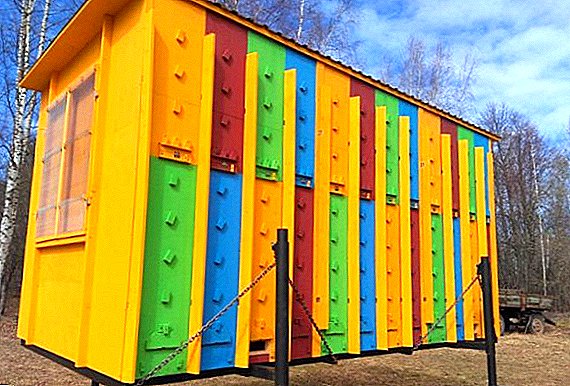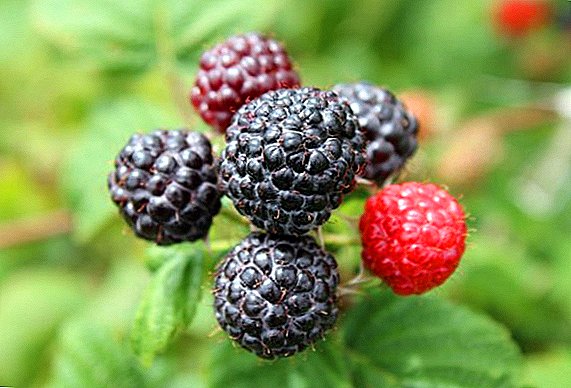 Among poultry farmers and farmers, Kholmogor geese are popular because of their high-quality meat and unpretentiousness in cultivation. In this article we will give a description and tell you about the main characteristics of this breed, as well as how to choose and contain Kholmogory.
Among poultry farmers and farmers, Kholmogor geese are popular because of their high-quality meat and unpretentiousness in cultivation. In this article we will give a description and tell you about the main characteristics of this breed, as well as how to choose and contain Kholmogory.
Breed description
Geese of Kholmogory breed appeared by crossing Chinese and Arzamas geese. The first documented mention of them dates back to the end of the XIX century. 
The color of Kholmogory is white, gray or spotty, but the white plumage is considered the most valuable. Their legs and beak are yellow-orange. Birds have a strong build and a wide massive body. The geese 'back is straight, the neck is long, and the chest is well developed and deep.
Distinctive signs of Kholmogory are a twisted beak and a growth on the forehead (bump). Representatives of the breed with white plumage have a lump of orange color, in piebald and gray geese - dark. Under the beak they have a fold of skin (the so-called "wallet").
Breed performance
During the year, Kholmogory geese produce 30-45 eggs weighing from 180 to 200 grams. They are good hens, hatchability is 50%, of which up to 90% survive.
Check out the list of the best breeds of geese, with a general characteristic of black and white geese, and also learn about the peculiarities of breeding Linda and the White-fronted Goose.
Chicks quickly gain weight and in 9 weeks already weigh up to 4.5 kg. The maximum weight of adult gander reaches 12 kg, geese - up to 8 kg. 
Upon reaching the age of three, geese of this breed may already acquire offspring. Their life expectancy in suitable conditions can reach 17 years. They adapt well to different conditions due to their acclimatization abilities.
Kholmogory residents at home
It is easy to grow geese of the Kholmogory breed, however there are some points that you should pay attention to.
Conditions of detention
A spacious room for geese will help keep the floor clean and dry and will protect the hill inhabitants from many diseases. It should be spacious - 1 square meter per individual. In warm climatic conditions, when geese spend most of their time outdoors, the floor space may be reduced to 0.5 square meters. m
Important! The most suitable material for the construction of the goose - tree, as it retains heat well.

It is necessary to protect the geese from drafts, because they are very vulnerable to the wind. It is necessary to install the door on the side where there is no draft.
In winter, it is necessary to make flooring out of materials for heat preservation, such as peat and straw, on the floor of the goose. In spring and summer, sawdust or sand covered with straw cutting are used as bedding. When the litter becomes wet, it must be replaced with a dry one, otherwise the hill people will risk catching a cold.
Kholmogorsk geese are great lovers of water, if possible they should be driven out to swim in the river or build an artificial reservoir for them.
Feeding Kholmogory
From the proper nutrition of geese depends on the rate of weight gain and bird health. To grow healthy Kholmogory, feeding characteristics must be correlated with the season and egg production. 
The geese start to rush from February, during this period the birds need about 160 g of feed, which should contain grains, legumes, chopped hay and roots. Gander in the breeding season reduces the weight, so their diet should contain food of animal origin: cottage cheese, raw eggs, meat and bone meal.
Feeders must contain chalk and gravel. In the morning the geese will be useful wet food, and in the evening dry. In order for the birds to digest food well, they must have plenty of drink.
It will also be useful for you to find out when domestic geese start to rush than goose fat is useful.
In spring and summer, Kholmogory residents need to walk to pasture, where they can eat up to 2 kilograms of grass per day.
Breeding Kholmogorskaya breed
Kholmogorskie acquire offspring, ranging from 3 years. For their breeding does not need an incubator, because they are good chicks and parents. However, skill and patience in this matter will still be required. 
Following these rules, you can get up to 15 goslings a month:
- on four geese in a flock there must be one gander;
- it is necessary to teach the goose to hatch eggs in its nest;
- the period of storage of eggs for incubation should not exceed 15 days;
- you need to check the goose for the ability to not leave the clutch in stressful conditions.
Did you know? Geese have good hearing and distinguish sounds at a distance of more than 50 meters.
On average, the process of hatching eggs takes 4 weeks, but you can add a few more days to this period. Whether a chick will appear from goose eggs can be understood on the 11th day. They should be visible red point with vessels departing from it, this is the future circulatory system of a gosling.
Read the table of incubation of goose eggs at home, learn about the features of growing goslings in the incubator.
Features of the content of goslings
The correctness of feeding and maintenance of chicks of Kholmogory breed depends on their age: 
- diurnal goslings. Before feeding, they must be allowed to dry, then immediately give food. In the first three days they need to be fed 4-6 times a day, giving them boiled eggs and crushed grain. It is necessary to keep the chicks in a tall box so that they cannot get out of it on their own. A lamp is installed above the goslings to maintain a temperature of + 28-29 ° C. One square meter of territory is designed for 10 goslings;
- goslings age from 4 days to a month. In four-day chicks, the temperature in their box should be maintained at + 27 ° C, from the sixth day of life - about + 25 ° C, from 8 to 10 days it should be + 24 ° C, from 11 to 15 days - + 22 ° C . On all subsequent days, the temperature should be maintained at + 18 ° C. Starting from the second week, they should be given food as adult hill mounts; you can add grass to the diet. At the same time they should be let to the mother;
- geese from a month and older. At this stage, it is necessary to introduce into the diet protein of plant origin, good sources of this substance - nettle and peas. Feeding is carried out 4 times a day. There should be no more than two chicks per square meter.
Important! The first time you need to look after your geese is because, if they fall on their backs at a young age, they will not be able to climb on their own and may die.

Immunity of the goslings is not yet strong, so the chicks can be exposed to a variety of infections. This can save them from diseases such as salmonellosis, cholera, pasteurellosis and others.
Goslings are usually vaccinated at the age of 3-4 weeks, but it is necessary to take into account such factors as the composition of the vaccine, the degree of spread of the disease and the presence of immunity in parents.
Learn how to feed the goslings.
Health and Diseases
Geese of the Kholmogory breed are in good health and live up to 17 years, however, if they do not comply with quality care, they may have health problems.
The main points that you should pay close attention to when raising these birds:
- drafts. Because of them, geese can get sick and, as a result, die;
- tightness If the geese do not respect the correct size of the room, they will start having problems with their legs. If possible, you need to walk the birds and let them swim.

Among the diseases of Kholmogory residents are:
- Rickets. In representatives of the breed with this disease, the bones and beak become soft, the geese carry eggs with soft shells. To cure geese, it is necessary to provide them walks under the sun, enter into the diet of fish oil, yeast and vitamin D.
- Parasites. Individuals with parasites develop poorly, they have low egg productivity. In this case, you need to disinfect the birds and their cages, and then process their fluff with a special ointment.
- Food poisoning. This can happen if the Kholmogorsk residents have used poor quality or inappropriate feed. They may experience convulsions, vomiting, diarrhea, high fluid intake. Treat birds with a weak solution of vinegar, vodka and vegetable oil.
Get to know the main diseases of geese and how to deal with them.
How to choose and where to buy geese
It is necessary to buy geese for breeding only in proven farms with positive reviews, otherwise there is a risk to buy a fake. 
Did you know? Geese choose a mate at the age of three and remain monogamous throughout life.
Kholmogory characterized by good survival of the young, but when choosing a goose, be sure to carefully look at these points:
- mobility. Healthy chicks are distinguished by constant bustle and restlessness. To check, you can throw a piece of paper in the box, the healthy goslings will react to it, and the weak will not pay attention;
- excellent appetite. Health friendly chicks eat a lot;
- soft tummy and closed umbilical cord. In unhealthy chicks in the abdomen, irregularities can be found;
- down Healthy goslings have a shiny down without a bald spot;
- reaction to the sound. You can knock on the box, and healthy chicks fuss.

How to transport birds
It is possible to transport the acquired goslings in a usual box with the holes made inside. The box must be large in size so that the chicks do not harm each other. The bottom should not be soft and fall, otherwise the birds may be injured and die.
Adult individuals are transported in special wire containers or cages. In no case should you knit the hill hills and put them in a bag. It is necessary to give them water before transportation and immediately give a drink upon arrival.
Kholmogory geese are unpretentious in their care and responsibly treat offspring. Adhering to proper care, you can grow healthy Kholmogory with good weight and a high level of egg-laying geese.
Feedback from network users



